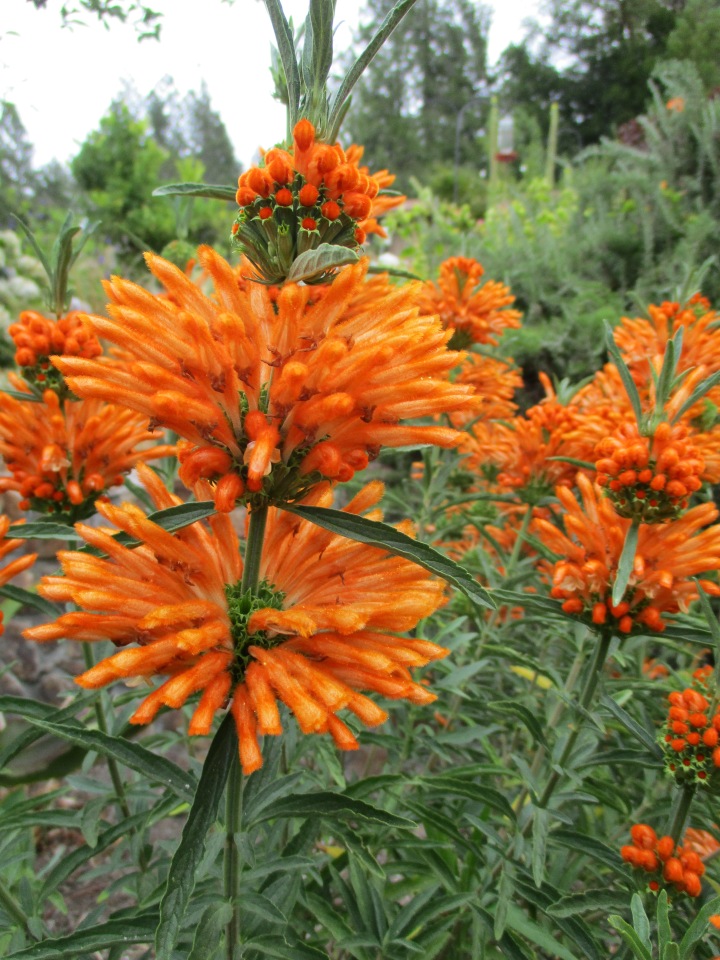 Are warm season annuals really the most colorful flowers for summer? Perhaps. They have their limits though. They are also very demanding. They need to be watered very regularly, and should probably be fertilized too. Many need to be deadheaded frequently. After all that, they are only temporary, and will get replaced with cool season annuals in autumn. Perennials are more practical.
Are warm season annuals really the most colorful flowers for summer? Perhaps. They have their limits though. They are also very demanding. They need to be watered very regularly, and should probably be fertilized too. Many need to be deadheaded frequently. After all that, they are only temporary, and will get replaced with cool season annuals in autumn. Perennials are more practical.
Lily-of-the-Nile is likely the most common and most familiar of blooming summer perennials. It is a shame that it blooms only once. Bloom is usually in time for the Fourth of July, and lasts a good long time, but is already fading. Deadheading as the blue or white color is eventually exhausted will not promote subsequent bloom, but will keep the evergreen foliage looking tidy until next year.
Daylily might be the second most popular of summer perennials. Some of the older types bloom only once like lily-of-the-Nile, but various cultivars bloom at various times to prolong the season if a few are grown together in the same garden. The most popular modern cultivars probably bloomed earlier, and will bloom again, perhaps with little time in between. The color range is extensive.
Penstemon are not committed to their natural schedule of blooming in late spring and again in autumn. A good pruning at the end of winter eliminates tired old foliage, and enhances and delays bloom until summer, without compromising the later autumn bloom. Like daylily, a few different varieties of penstemon in the same garden prolong bloom, which can be white, pink, red or purple.
Salvias are a big group of summer perennials that really should be more popular than they are. Some are native. Others are from other chaparral climates. Naturally, they are right at home here. Many bloom about now, and some will bloom again in autumn if deadheaded or pruned back. What they lack in flashy color, they compensate for in resiliency and reliability. They really are tough.
This is by no means a complete list of summer perennials. It does not even include the perennial daisies such as coneflower, black-eyed Susan and gaillardia.
Salvias are a mainstay in my garden. They come up every year and the critters don’t eat them.
LikeLiked by 1 person
They are here too, because some of them are native. Those that we plant are garden varieties of the natives, but there are a few that come up on their own and stay. They are rad!
LikeLiked by 1 person
Great post as always! I have a patch of very old daylilies that doesn’t flower that long. I drive by a farm every day that has a couple of yellow flowering daylilies that have HUGE flowers and have been flowering for several weeks. It seems hard to believe their flowers only last one day. Maybe the newer hybrids flowers last more than one day otherwise how have they been flowering nonstop for several weeks… I have never been a big daylily fan so I haven’t checked into the newer hybrids. I didn’t plant any annuals this season. I got off to a weird start because of the continual rain so my beds don’t look so well this year. Then it got hot and I have been pretty busy. I always enjoy your posts when I have time to read. Thanks for sharing!
LikeLiked by 1 person
You are welcome, and thank you.
Individual florets of the daylily blooms should last about a day, but really last two or three days. They seem to bloom longer because new florets bloom as the olde ones fade. Healthier plants bloom longer just because they put out more buds that bloom in sequence. Also, some modern cultivars really do have longer bloom seasons. I still would not recommend removing what you have, even if you just dig them and put them somewhere else. Old cultivars have certain advantages too.
LikeLiked by 1 person
Hmm, I love Leonitis, it finished 3 months ago here and Agapanthus I do believe is hopeless as are Black-Eyed Susans, welcome to Florida. Love your photos!
LikeLiked by 1 person
Crazy! I would not have guessed that there is anyplace outside of the Arctic and Antarctic where agapanthus would not grow. I can believe that black-eyed Susan would not grow there, because, although pretty universal, I know of situations where it would not be happy.
LikeLiked by 1 person
The Agapanthus grows foliage but has never flowered. I agree, crazy.
LikeLiked by 1 person
Ok, but what’s the orange flower?
LikeLiked by 1 person
Lion’s tail, Leonotis leonurus
LikeLike
Aha! Thanks!
LikeLiked by 1 person
You are welcome.
LikeLike
I would think that Tithonia would grow really well where you are. In my garden it requires no supplemental watering, though I imagine in your climate it probably would. I agree that perennials should be the backbone among garden flowers, but I like to mix in a few of the more carefree annuals among them.
LikeLiked by 1 person
Tithonia is mediocre here. I do not know why. It can be grown, and does reasonably well, but never really proliferates. It is not very popular either. There are a few annuls that are somewhat carefree, but most are limited to areas that get at least some sort of watering, which are also the same sorts of areas where wildflowers are not allowed to stay.
LikeLike
Well, you’ll always have nasturtiums and CA poppies.
LikeLiked by 1 person
In two separate areas of course. Those are too things that don’t go together, and would bee too much orange.
LikeLike